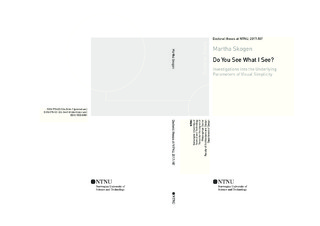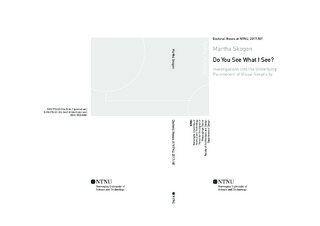| dc.contributor.advisor | Øritsland, Trond Are | |
| dc.contributor.author | Skogen, Martha | |
| dc.date.accessioned | 2017-07-19T11:16:17Z | |
| dc.date.available | 2017-07-19T11:16:17Z | |
| dc.date.issued | 2017 | |
| dc.identifier.isbn | 978-82-326-2447-8 | |
| dc.identifier.issn | 1503-8181 | |
| dc.identifier.uri | http://hdl.handle.net/11250/2449003 | |
| dc.description.abstract | Motivated by a longstanding interest in timeless design, this research focused on visual simplicity due to its potential as a core value of a design’s longevity. Multiple studies were conducted to investigate how people view, interpret, and understand visual stimuli, with simplicity as a fundamental aesthetic approach. The research goal was to uncover what the underlying components of visual simplicity may be, and how people judge those components. The research into visual simplicity is rooted in the following questions:
I. What is visual simplicity and what are the graphic design
parameters that determine it?
II. How do people interpret visual simplicity?
III. Does everyone agree?
The range of visual stimuli tested here included aspects of the real world as well as the computer realm. The stimuli included (in order): CD covers, architecture and/or public spaces, miniaturized poster art, graphical user interface (‘GUI’) screen layouts and GUI icons. The initial studies included adult participants only. Results revealed a consistency in responses: In both the real world and GUI realms, adults answered consistently that “simple” design meant a scant amount of detail and minimal use of line, color, and other graphic design parameters— whereas “complicated” visual design meant the opposite. For adults, there seemed to be a reliable set of design parameters that when combined, elicited a “simple” or “complicated” response to a visual design, regardless of media. However, the final set of studies revealed an unforeseen phenomenon: youths ( ≤ age 13) did not respond consistently with adults. In general, youths did not consistently associate detail-scant GUI icons with simplicity, but in many cases with being more complicated. This revealed a possibility that people go through a period of transition during which they change their interpretations of minimalized, abstracted imagery and then associate those characteristics with being “simple”. This phenomenon led to a discussion regarding the potential existence of ‘visual archetypes’ and how they might be interpreted by viewers of various ages. ‘Visual archetypes’ refer to a design that uses the least amount of visual information required to communicate the message.
The contributions of this doctoral research include:
• expanded awareness of design parameters that are associated with the relationship between visual Simplicity-Complicated
• insight into the emotional aspects connected with visual Simplicity-Complicated
• awareness that not all viewers interpret Simplicity-Complicated identically (age-based differences were revealed—there may be other differences)
• recognition of the possibility for unintentional design presumptions
• discussion of visual archetypes
This research contributes to the design community by demonstrating that people can interpret design differently than designers might presume and/or intend. Although the research raises awareness of potential interpretive differences between children and (primarily) midlife adults, the discussion can perhaps apply to seniors as well. Importantly, the research revealed that children are highly capable interpreters of our culturally- and computer-based visual information. | nb_NO |
| dc.language.iso | eng | nb_NO |
| dc.publisher | NTNU | nb_NO |
| dc.relation.ispartofseries | Doctoral theses at NTNU;2017:187 | |
| dc.relation.haspart | Paper 1:
Skogen, Martha Rice.
Simplicity in Complicated User-Interface Applications.
Nordcode05, 4th Nordcode Seminar & Workshop | |
| dc.relation.haspart | Paper 2:
Skogen, Martha Rice.
Visual White Space and Emotional Exclusivity: A Student Exercise. Design & Emotion | |
| dc.relation.haspart | Paper 3:
Skogen, Martha Rice; Berntsen, Hilde Østerås.
An Investigation into the Subjective Experience of White Space in an Urban Environment. Design & Emotion | |
| dc.relation.haspart | Paper 4:
Skogen, Martha Rice.
An Investigation into the Subjective Experience of Icons: A Pilot Study. IV06: Information Visualization 2006
http://dx.doi.org/10.1109/IV.2006.22 | |
| dc.relation.haspart | Paper 5:
Skogen, Martha
Say, What Did You See? A Qualitative Interview Reveals How
Users Interpreted GUI Icons.
9th Conference on Design & Emotion | |
| dc.relation.haspart | Paper 6:
Skogen, M. & Hoem, H.
What Can GUI Designers Learn from 2D Poster Art?
Viewers Responses Reveal Consistencies Across Diverse Media.
11th International European Academy of Design Conference —
The Value of Design | |
| dc.relation.haspart | Paper 7:
Skogen, M.
An Investigation into the Subjective Experience of GUI Icons:
Age Differences Revealed | |
| dc.title | Do You See What I See? Investigations into the Underlying Parameters of Visual Simplicity | nb_NO |
| dc.type | Doctoral thesis | nb_NO |
| dc.subject.nsi | VDP::Humanities: 000::Architecture and design: 140 | nb_NO |

